Buenas a todos mis queridos #Hivers ¿como han estado? hoy les vengo a mostrar mi experiencia armando una bestia de la ingeniería alemana, y clara muestra de la superioridad tecnológica de la antigua alemania nazi de la pre-guerra y como su legado perduro durante 40 años mas en tiempos de la post-guerra.
Good morning to all my dear #Hivers, how have you been? Today I come to show you my experience assembling a beast of German engineering, and a clear example of the technological superiority of the former Nazi Germany of the pre-war and how its legacy lasted for 40 more years in post-war times.

CASA C-352L (Ju 52/3m fabricado bajo licencia por CASA en España, antiguo T2B-212 del Ejército del Aire español), en estado de vuelo, 2007.

Les contare un poco sobre este avión el cual tiene mas de 50 años de historia activa a nivel mundial. Fue un avión de transporte alemán utilizado ocasionalmente como bombardero y también como avión de la cruz roja, dirigidos por la Lufwaffe (arma aérea en alemán) ; era un monoplano de ala baja con tren de aterrizaje fijo y revestimiento metálico, descendiente del Junkers F 13. A pesar de sus rasgos arcaicos, con tren de aterrizaje fijo, líneas angulosas y revestimiento corrugado, el Ju 52 no solo estuvo presente en todas las operaciones bélicas alemanas de la Segunda Guerra Mundial, sino que también participó en algunas de las denominadas "guerras de posguerra".

En 1927 los ingenieros de Junkers se ocupaban del desarrollo de un nuevo y gran monomotor de transporte en el que se resumía toda la experiencia acumulada en diseños anteriores y que estaba destinado en principio a trabajos de carga. Como sus predecesores, la construcción del nuevo modelo Ju 52 era típicamente Junkers, con revestimiento metálico en duraluminio corrugado y con la clásica "doble ala Junkers". El primer Ju 52/1m voló el 13 de octubre de 1930.

Al año siguiente, el equipo de diseño de Junkers (encabezado por el ingeniero Ernst Zindel) comenzó a evaluar y a trabajar en la adaptación de otros dos motores en las alas, y motivó que la séptima célula fuese extraída de la cadena de montaje y convertida en el prototipo del Junkers Ju 52/3m (3m por Dreimotoren, trimotor); estaba propulsado con tres Pratt & Whitney Hornet de 550 hp, y realizó su vuelo inaugural en abril de 1931. Las prestaciones de este Ju 52/3mce fueron tan marcadamente superiores a las de la versión monomotor, que se decidió suspender la producción de esta. El primer comprador fue el Lloyd Aéreo Boliviano, que recibió siete ejemplares a partir de 1932.
Referencia
I will tell you a little about this plane which has more than 50 years of active history worldwide. It was a German transport aircraft used occasionally as a bomber and also as a red cross aircraft, run by the Lufwaffe (German air weapon); was a low-wing monoplane with fixed landing gear and metallic cladding, descended from the Junkers F 13. Despite its archaic features, with fixed undercarriage, angular lines and corrugated cladding, the Ju 52 was not only present in all German war operations of World War II, but also participated in some of the so-called "postwar wars".
In 1927, the Junkers engineers were working on the development of a new and large transport single-engine engine, which summed up all the experience accumulated in previous designs and which was originally intended for loading work. Like its predecessors, the construction of the new Ju 52 was typically Junkers, with corrugated duralumin metal cladding and the classic "Junkers double wing". The first Ju 52 / 1m flew on October 13, 1930.
The following year, the Junkers design team (led by engineer Ernst Zindel) began evaluating and working on fitting two other engines in the wings, prompting the seventh cell to be pulled off the assembly line and converted into the Junkers Ju 52 / 3m prototype (3m for Dreimotoren, trimotor); It was powered by three 550-hp Pratt & Whitney Hornets, and made its maiden flight in April 1931. The performance of this Ju 52 / 3mce was so markedly superior to that of the single-engine version that it was decided to discontinue production. The first buyer was the Lloyd Aéreo Boliviano, which received seven copies starting in 1932.

Junker Ju-52/3m, diseño de transporte tactico de la Luftwaffe

Referencia
Dibujo 3 vistas del Junkers Ju 52.
Estallido de la segunda guerra mundial

Multiples Junkers ju 52 en el frente africano

Fue modelo básico para el transporte de tropas, operaciones de control nocturno y lanzamiento de paracaidistas en Polonia, Noruega, Bélgica, Holanda, Creta, Norte de África y el frente del Este (Específicamente la unión soviética, o URSS ( Unión de Repúblicas Socialistas Soviéticas)). También sirvió como avión de la cruz roja y como bombardero en la invasión a Polonia, en el frente africano y en la operación Barbarroja, por mencionar solo algunas.
Referencia

Precisamente en 1942, en las bases aéreas de Pitomnik y Gumrak fue donde el Ju 52 realizó su máximo esfuerzo en la lucha por esta ciudad ayudando a llevar pertrechos y tropas de refresco, así como a evacuar a los heridos del VI Ejército de Friedrich Paulus durante la Batalla de Stalingrado. Cabe destacar que el Junker Ju52 octuvo 15 variantes de dicho modelo, siendo cada vez mas efectivo, moderno y con trenes de aterrizaje intercambiables, tanto para tierra, nieve y agua.
It was a basic model for the transport of troops, night control operations and paratroopers in Poland, Norway, Belgium, Holland, Crete, North Africa and the Eastern front (specifically the Soviet Union, or USSR (Union of Soviet Socialist Republics )). It also served as a Red Cross aircraft and as a bomber in the invasion of Poland, on the African front, and in Operation Barbarossa, to name just a few.
Precisely in 1942, it was at the Pitomnik and Gumrak air bases where the Ju 52 made its maximum effort in the fight for this city, helping to carry supplies and refreshment troops, as well as to evacuate the wounded of Friedrich Paulus's VI Army during the Battle of Stalingrad. It should be noted that the Junker Ju52 has 15 variants of this model, being increasingly effective, modern and with interchangeable landing gears, both for land, snow and water.

Fallschirmjäger lanzándose desde Ju 52 en mayo de 1944.

Referencia

Fotografia del museo de aviacion, Belgrado
La historia de la "Tante Ju" (Tía Ju, apodo cariñoso de sus pilotos) no acabó el día de la victoria aliada, cuando solo unos 50 ejemplares de los 4835 construidos permanecían en estado operativo. El principal usuario de posguerra fue Francia, con casi 400 ejemplares construidos por Ateliers Aéronautiques de Colombes (anteriormente Avions Amiot) con la designación AAC 1 Toucan (Tucán), de los que 85 prestaron servicios comerciales en la posguerra con Air France y otras muchas líneas aéreas francesas. El Toucan sirvió en la Armée de l´Air y la Aéronavale, y fue empleado en misiones de transporte y lanzamiento de paracaidistas en Argelia e Indochina.

En España, Construcciones Aeronáuticas S.A. adquirió su licencia en 1942 y fabricó 170 ejemplares para el Ejército del Aire con las siglas CASA C-352L y la designación militar T.2 con motores ENMASA Beta E9C de 750 hp (BMW 132). El primer ejemplar realizó su primer vuelo en 1944. Los C-352L intervinieron activamente en la guerra de Ifni en 1957-58.

Volaron como aviones civiles además en Finlandia con Aero O/Y, Suecia con AB Aerotransport; en países de Sudamérica, como Colombia, que usó uno adquirido en 1933, el Junkers Ju 52/3mce FAC-625, el cual prestó su servicio inaugural con el presidente Olaya Herrera. Otros países que lo usaron fueron China y Sudáfrica con South African Airways (SAA). La compañía Iberia utilizó también un pequeño número. Diez Ju 52 serían reconstruidos en Gran Bretaña y entraron en servicio con BEA en las postrimerías de 1946.

Los últimos ejemplares militares en estado operativo de que se tiene noticia fueron tres transportes Ju 52/mg4e de las Fuerzas Aéreas de Suiza; dos fueron dados de baja en 1983.
The history of the "Tante Ju" (Aunt Ju, affectionate nickname of its pilots) did not end on the day of the Allied victory, when only about 50 copies of the 4835 built remained in operational condition. The main post-war user was France, with almost 400 units built by Ateliers Aéronautiques de Colombes (formerly Avions Amiot) under the designation AAC 1 Toucan (Toucan), of which 85 provided post-war commercial services with Air France and many other lines. French airships. The Toucan served in the Armée de l´Air and the Aéronavale, and was used in transport and parachute drop missions in Algeria and Indochina.
In Spain, Construcciones Aeronáuticas S.A. acquired its license in 1942 and manufactured 170 copies for the Air Force under the acronym CASA C-352L and the military designation T.2 with 750 hp ENMASA Beta E9C engines (BMW 132). The first specimen made its maiden flight in 1944. The C-352L were actively involved in the Ifni war in 1957-58.
They also flew as civil aircraft in Finland with Aero O / Y, Sweden with AB Aerotransport; in South American countries, such as Colombia, which used one acquired in 1933, the Junkers Ju 52 / 3mce FAC-625, which rendered its inaugural service with President Olaya Herrera. Other countries that used it were China and South Africa with South African Airways (SAA). The Iberia company also used a small number. Ten Ju 52s were to be rebuilt in Britain and entered service with the BEA in late 1946.
The last known military specimens in operational status were three Ju 52 / mg4e transports of the Swiss Air Force; two were decommissioned in 1983.

Tres Junkers Ju 52 construidos para South African Airways.

Cuatro Junkers Ju 52 construidos para Suiza Swissair
Mi experiencia personal
Ahora que sabemos un poco sobre el Junkers Ju 52 les presentare mi trabajo con dicho modelo el cual tuvo una duración de 4 días de armado, 6 días de pintado y un día creando la base. Este es unJunker Ju 52/3mg5e versión militar con tres motores BMW 132T de 830 hp, deshielo por aire caliente, tren de aterrizaje intercambiable (esquíes) y radio mejorada.
My personal experience
Now that we know a little about the Junkers Ju 52 I will present my work with this model which lasted 4 days of assembly, 6 days of painting and one day creating the base. This is a Junker Ju 52 / 3mg5e military version with three 830hp BMW 132T engines, hot air de-icing, interchangeable undercarriage ( skis ) and improved radio.
Materiales utilizados/ Used materials
Pinturas/ paintings
- Humbrol authentic colour Light Aircraft Grey (HX5)
- Humbrol Enamel blanco mate (34)
- Humbrol Color Gris oscuro satinado (184)
- Humbrol Authentic colour Overall Green (HI 3)
- Vallejo Game color Imprim. blanco (72.002)
- Vallejo Model color Gris metalizado (70.863)
- Vallejo model color Plata (70.997)
- Vallejo Game color Lavado negro (73.201)
- Formula P3 Bootstrap Leather
- Formula P3 Arcane Blue
- Formula P3 Cygnus Yellow
- Formula P3 Cygnar Blue
- Formula P3 Greatcoat Grey
- Formula P3 IronHull Grey
- Formula P3 Ryn Flesh
- Formula P3 Cygnar Blue Highlight
- Formula P3 Armor Wash
- Formula P3 Flesh Wash
- Tamiya Color Negro mate (XF-1)
- Tamiya Color blanco (X-2)
- Acrilic Colour Yellow ochre
- Oro color Nieve gruesa (F091)
- Oro color Envejecimiento al aceite (W180)
Otros materiales/ Others materials
- Pincel 1/8 EVA-FOAM
- Pincel 000 Corona
- Pincel 00 Corona
- Pincel de imprimacion Army painter (BR7007)
- Small Drybrush Army painter (BR7009)
- Pega Loka 3
- Lijas de 180, 340, 1000, 2000 y 4000
- Agua destilada
- Alcohol al 100% y 70%
- Thinner acrílico
- Paleta de colores
- Oxido lijado
- Pinza de precisión
- bisturí
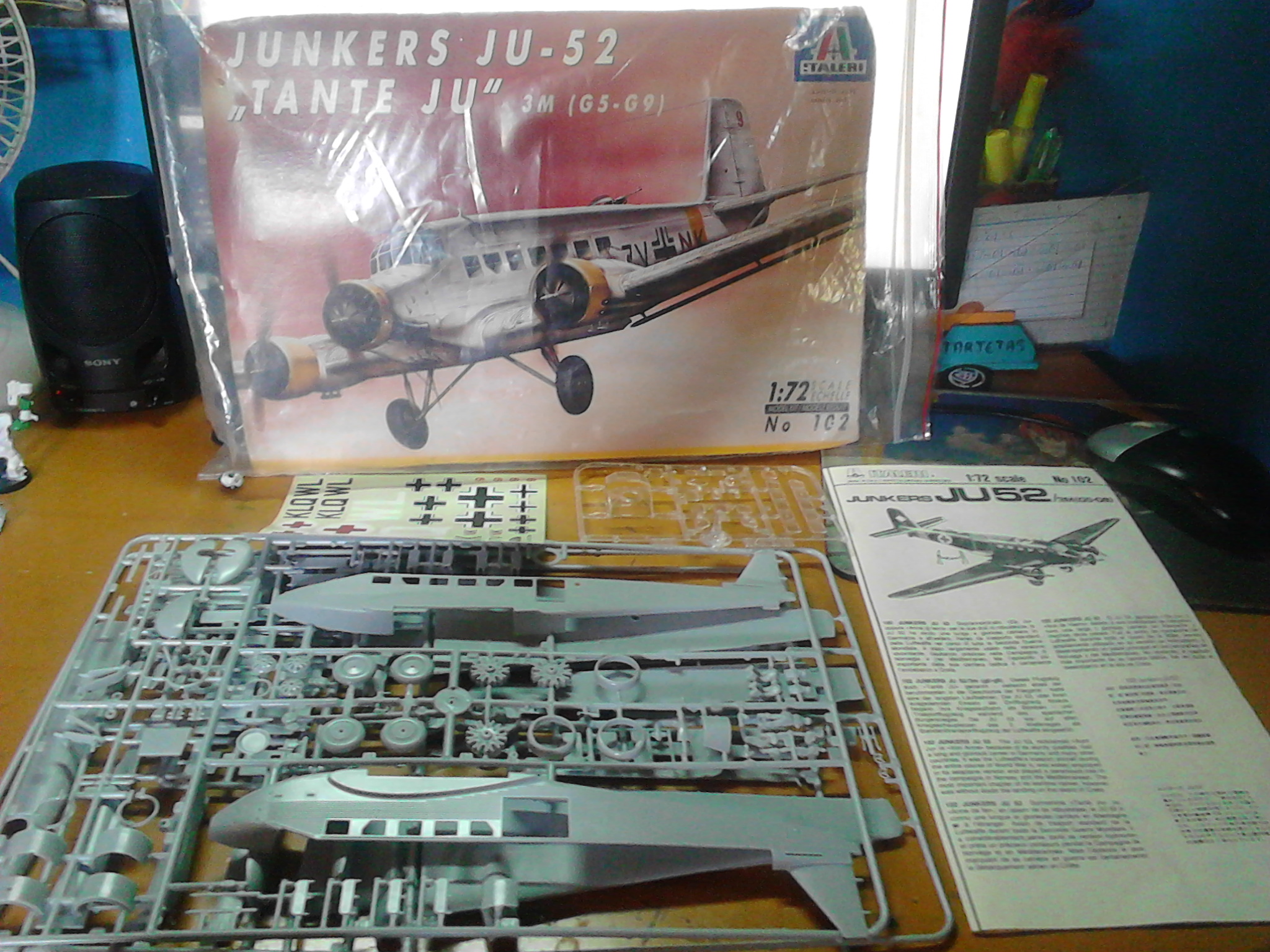
Fotografia tomada por mi en mi estudio de armado y pintado
Antes de comenzar el armado del modelo, lave todas las piezas con agua jabonosa, esto se hace para remover todo tipo de suciedad que pueda traer el modelo de fabrica . Tras remover las piezas de las bandejas se iban lijando cada una de ellas para eliminar las sobras del plástico que puedan traer.
Before starting the assembly of the model, wash all the parts with soapy water, this is done to remove all kinds of dirt that the factory model may bring. After removing the pieces from the trays, each one of them was sanded to remove any leftover plastic they may bring.
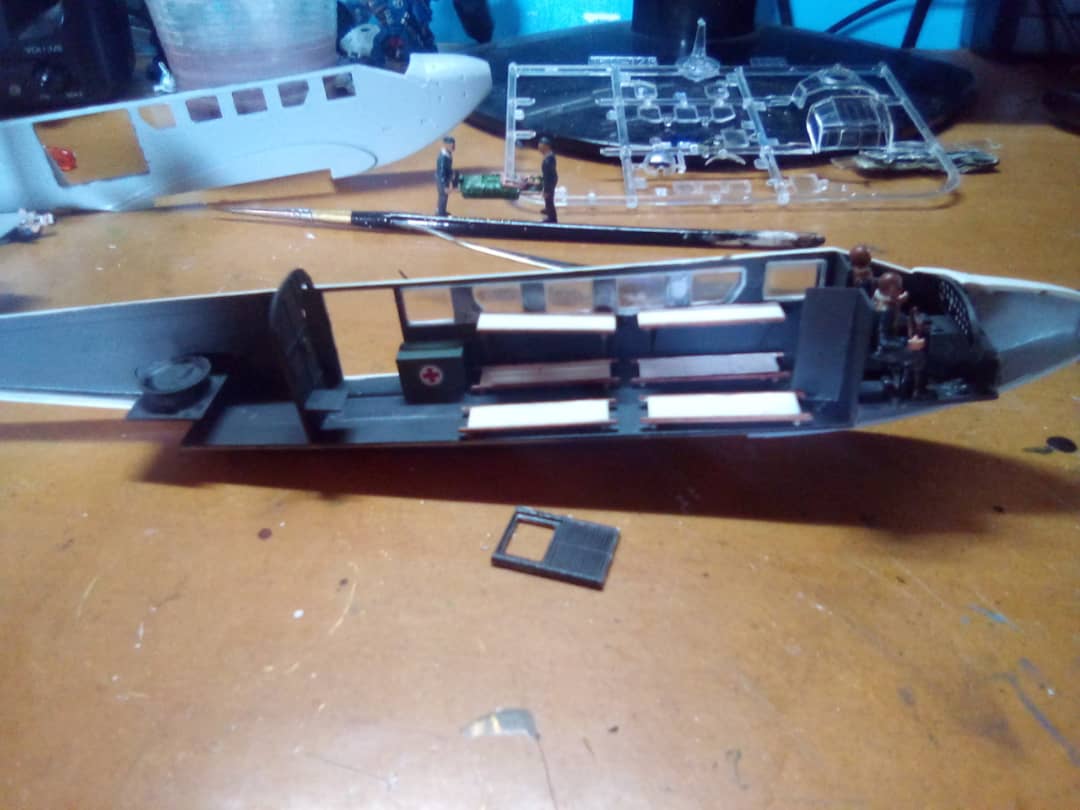
Interior del Junker Ju 52 de la cruz roja
Mientras se procedía con el armado se pintaba a la vez por dentro las diferentes piezas, al ser el modelo de la cruz roja en su interior no contenía las 20 sillas metálicas tradicionales ni las 4 ametralladoras MG-15, en cambio solo contenía 1 ametralladora MG-15, un botiquín de primeros auxilios y 8 camillas para heridos.
Luego de terminar con el interior, procedí al ensamblado exterior, y con su posterior pintado y añadido de calcomanias de agua y pigmentaciones correspondientes al este de Europa de 1943 en territorio soviético, en llegada del invierno.
While proceeding with the assembly, the different pieces were painted at the same time, since the model of the red cross inside did not contain the 20 traditional metal chairs or the 4 MG-15 machine guns, instead it only contained 1 MG machine gun. -15, a first aid kit and 8 stretchers for the injured.
After finishing with the interior, I proceeded to the exterior assembly, and with its subsequent painting and addition of water decals and pigmentations corresponding to eastern Europe in 1943 in Soviet territory, in winter.
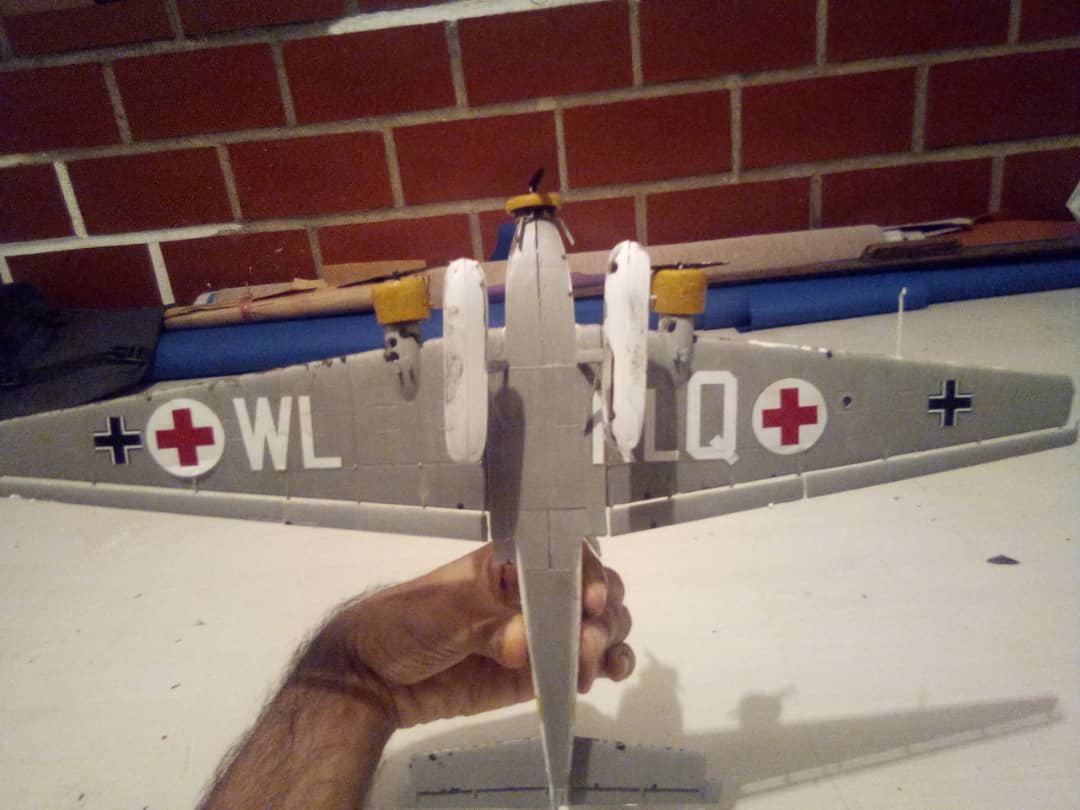
Parte inferior del avion
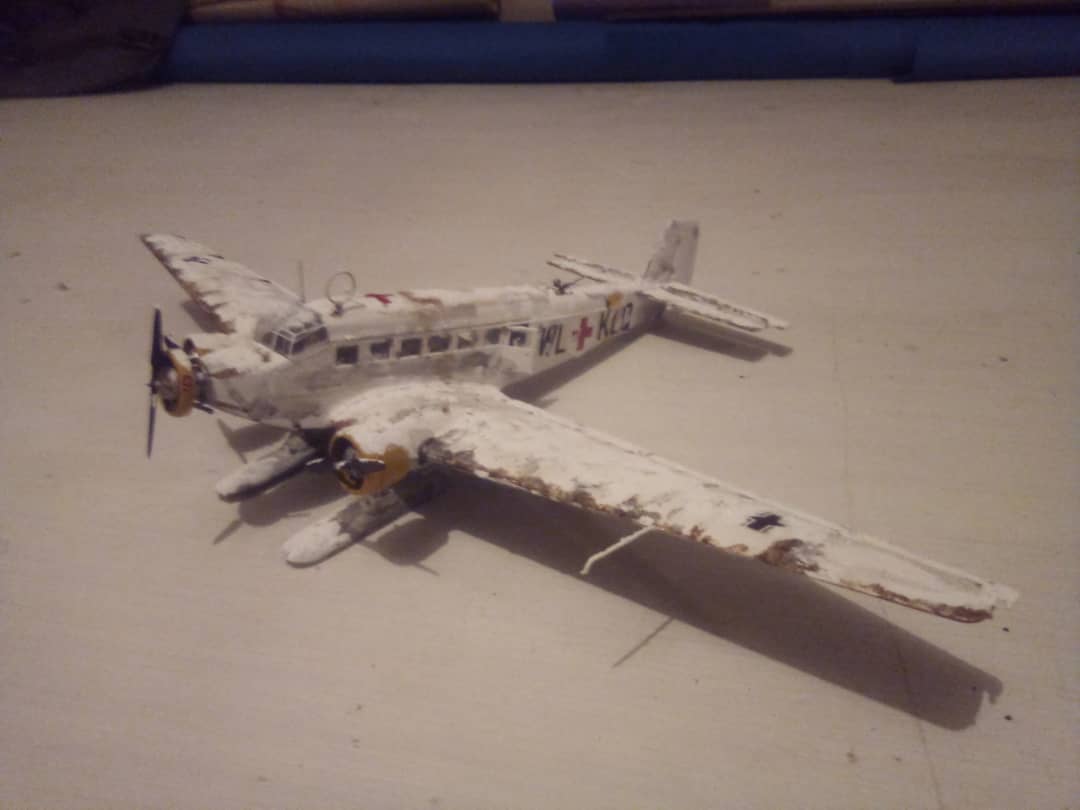
Vista supeior del avion
Luego diseñe la base del modelo tomando sus respectivas medidas utilizando una tabla de madera MDF vieja que tenia y luego hice los bordes con un trompo para darle un acabado en curva cerrada.
Then I designed the base of the model taking its respective measurements using an old MDF wooden board that I had and then I made the edges with a spinning top to give it a closed curve finish.
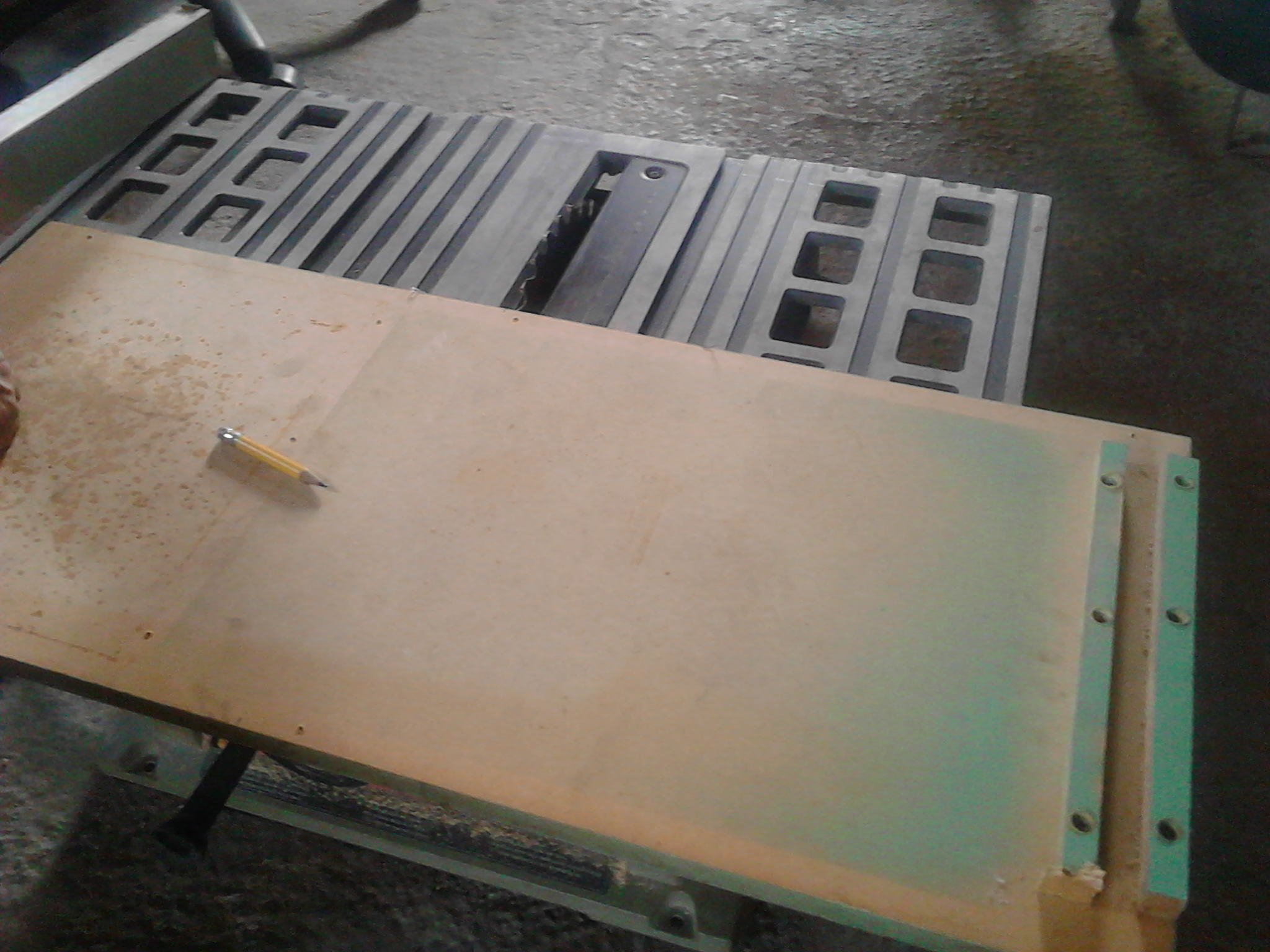
Tabla de madera antes se ser cortada
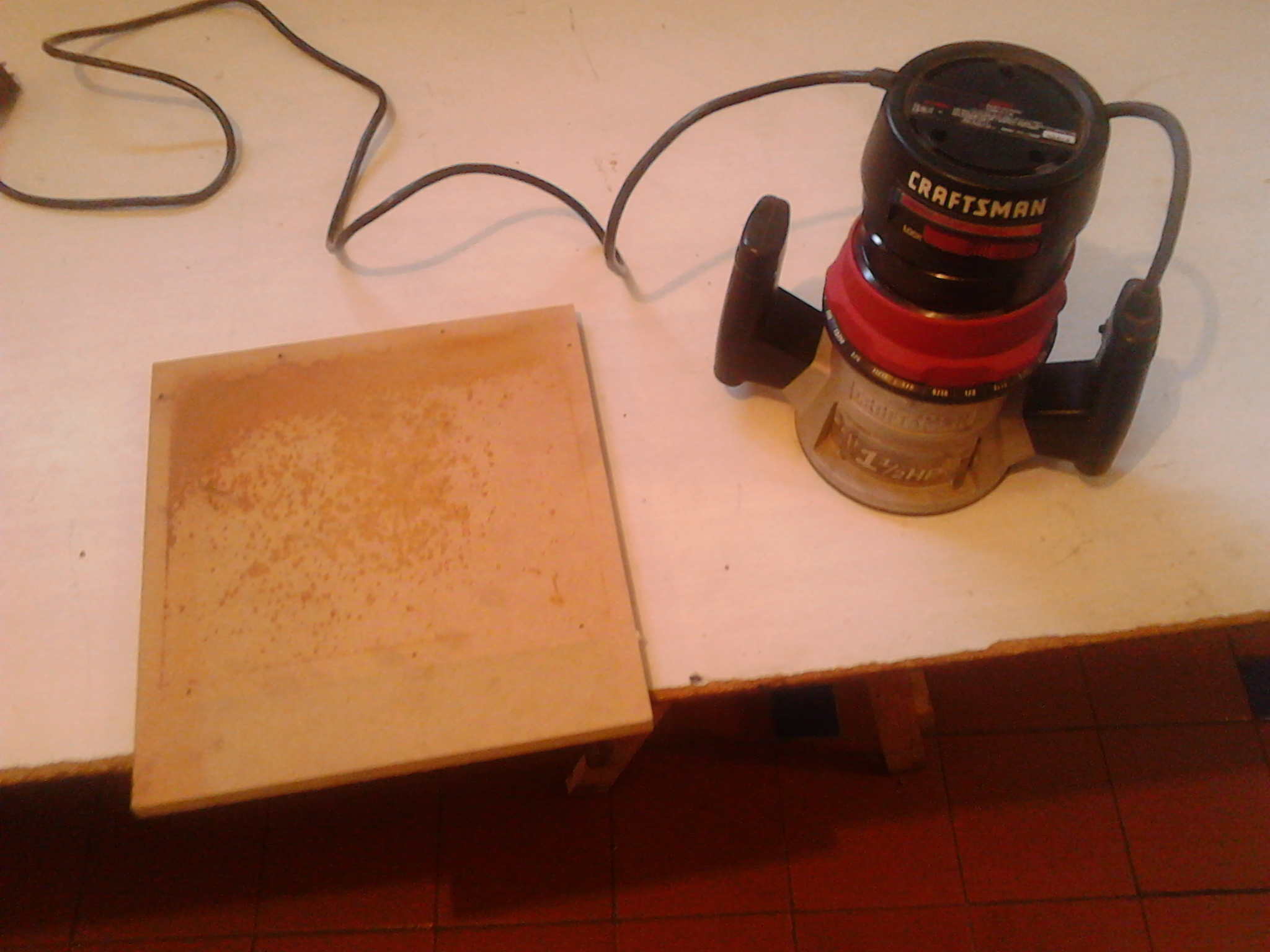
Trompo junto a la base de madera
Luego aplique a los bordes tinte caoba para madera y sellador acrílico para madera para finalmente aplicar la nieve gruesa sobre la base y colocar el modelo con sus respectivas miniaturas.
Then apply mahogany wood stain and acrylic wood sealer to the edges to finally apply the thick snow on the base and place the model with its respective miniatures.
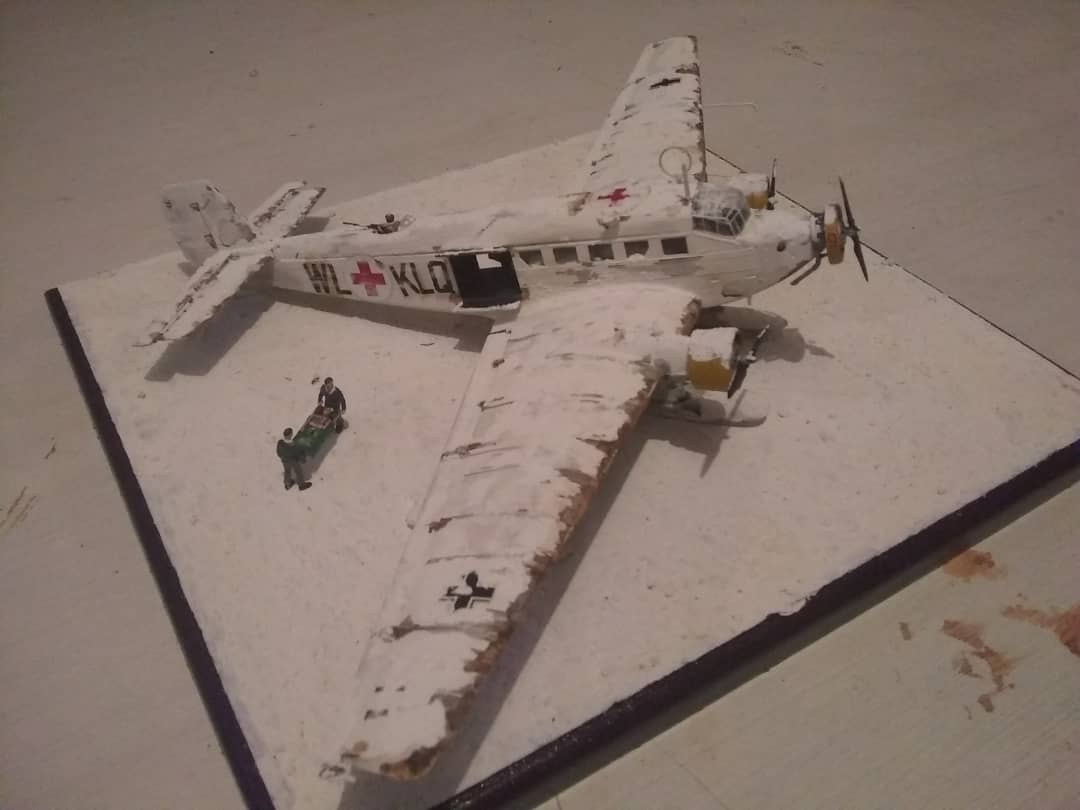

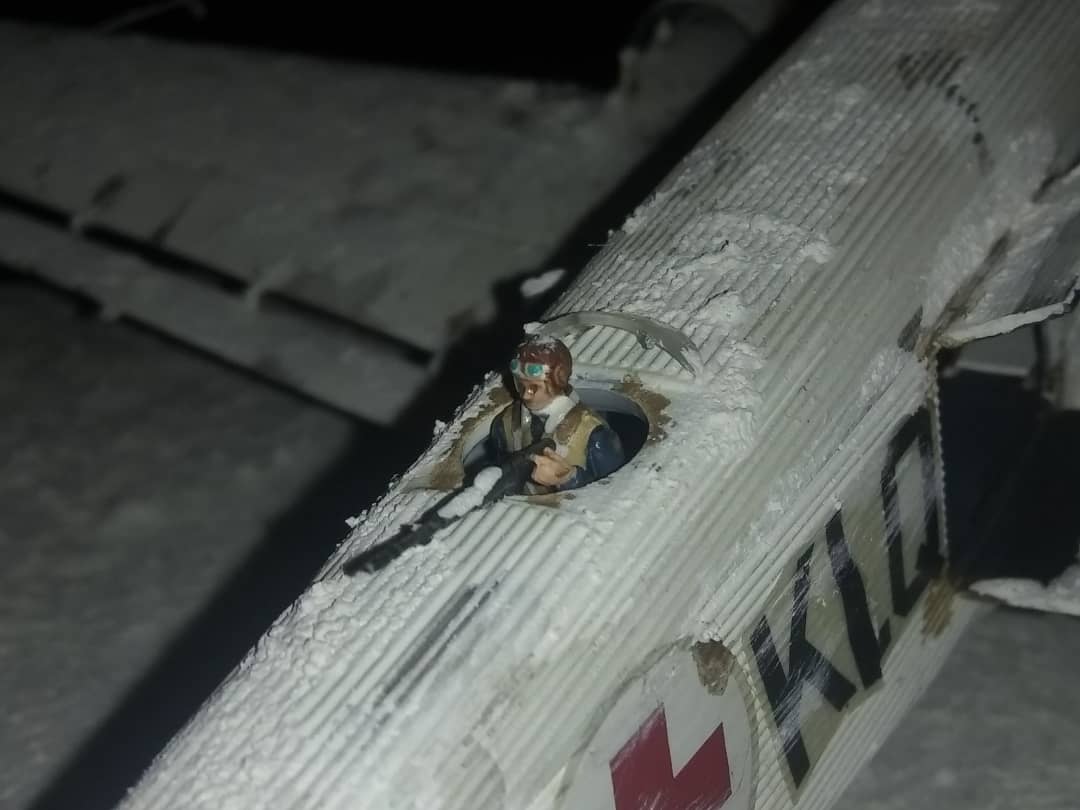
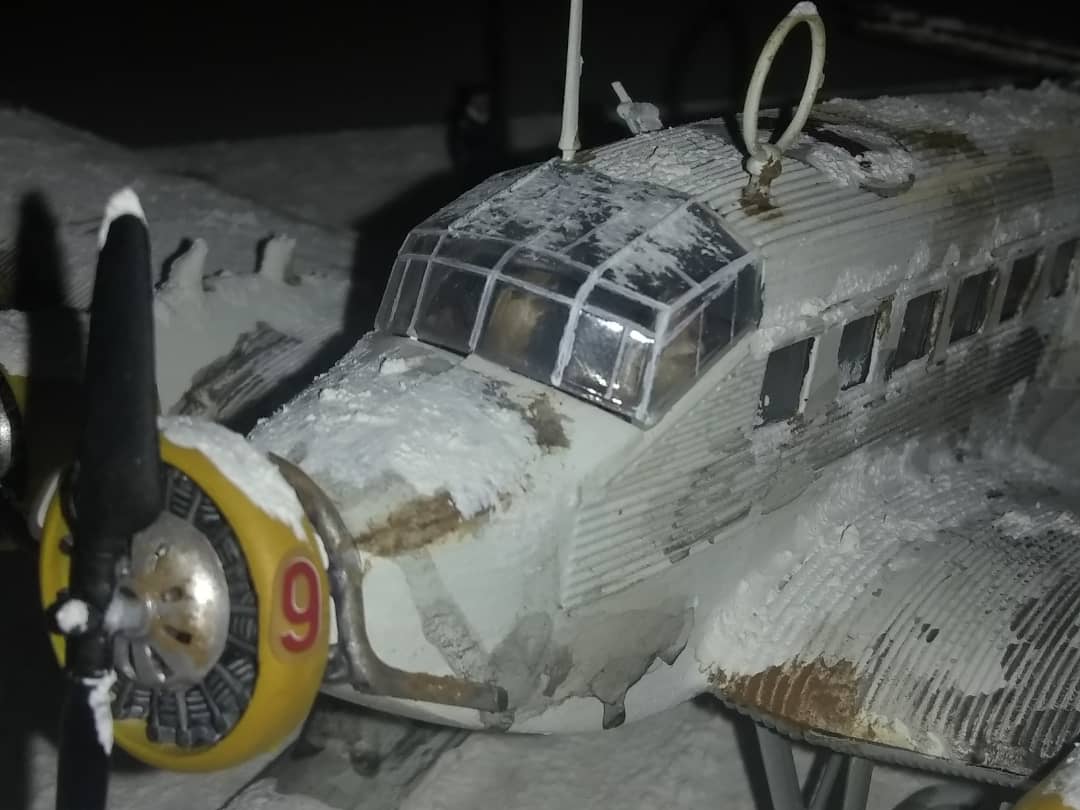
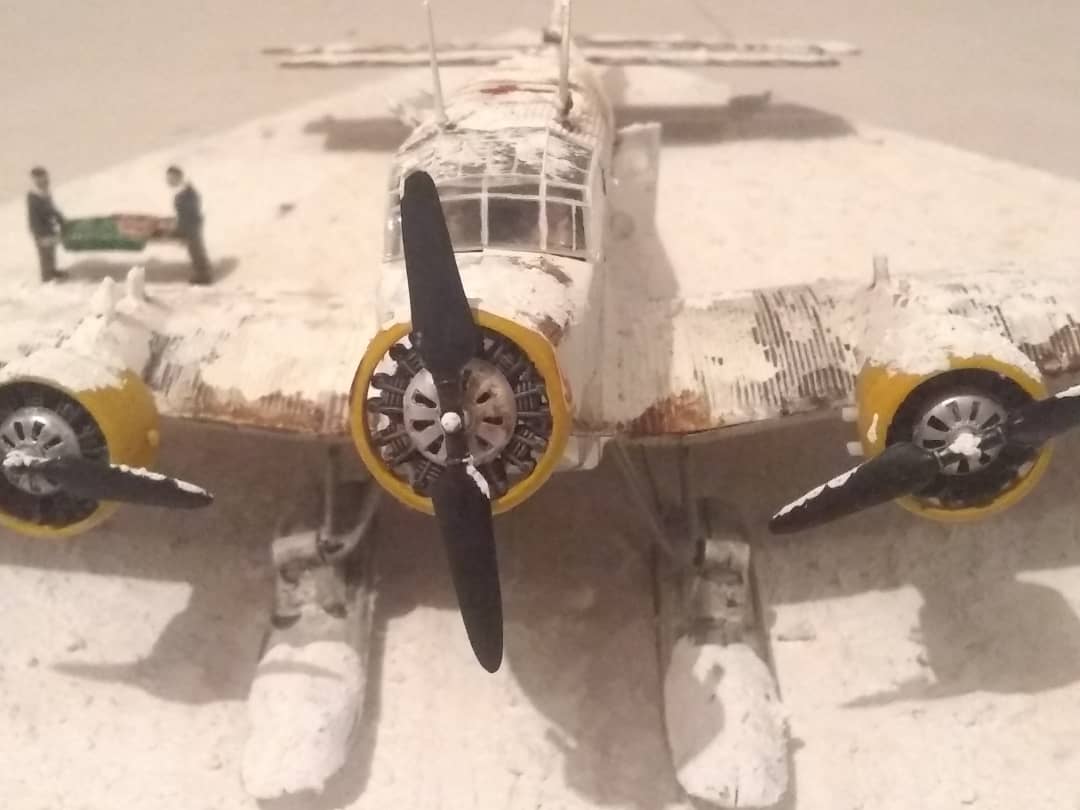
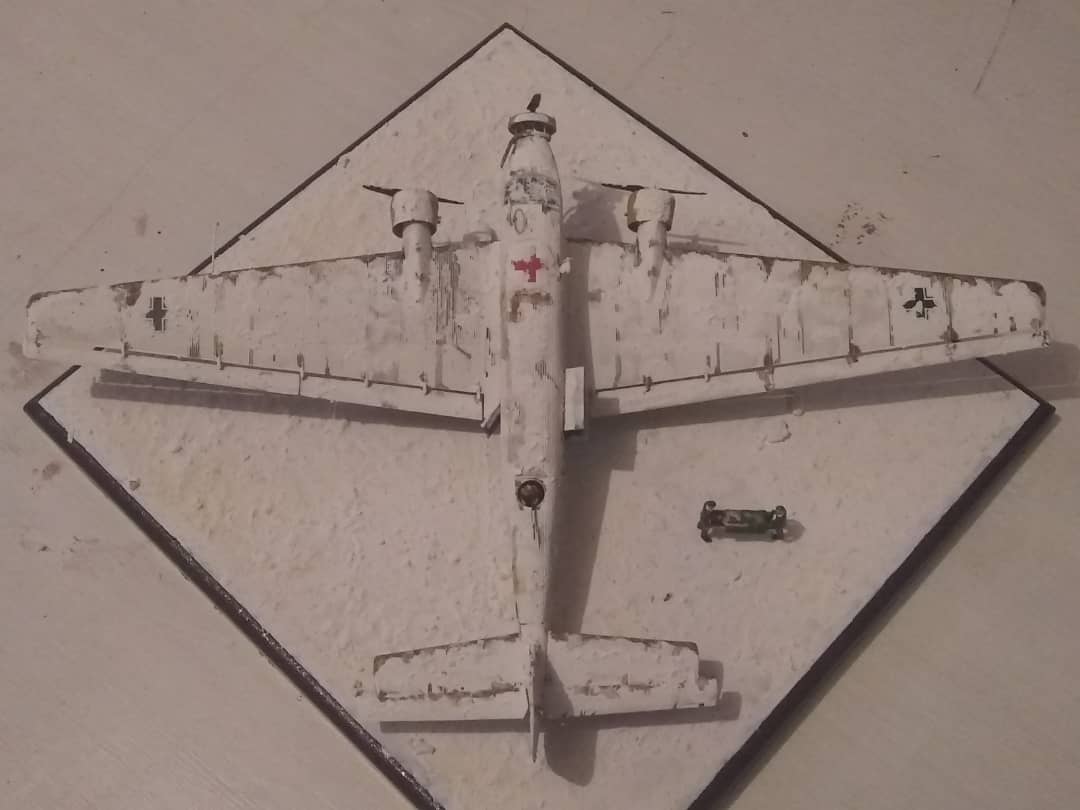
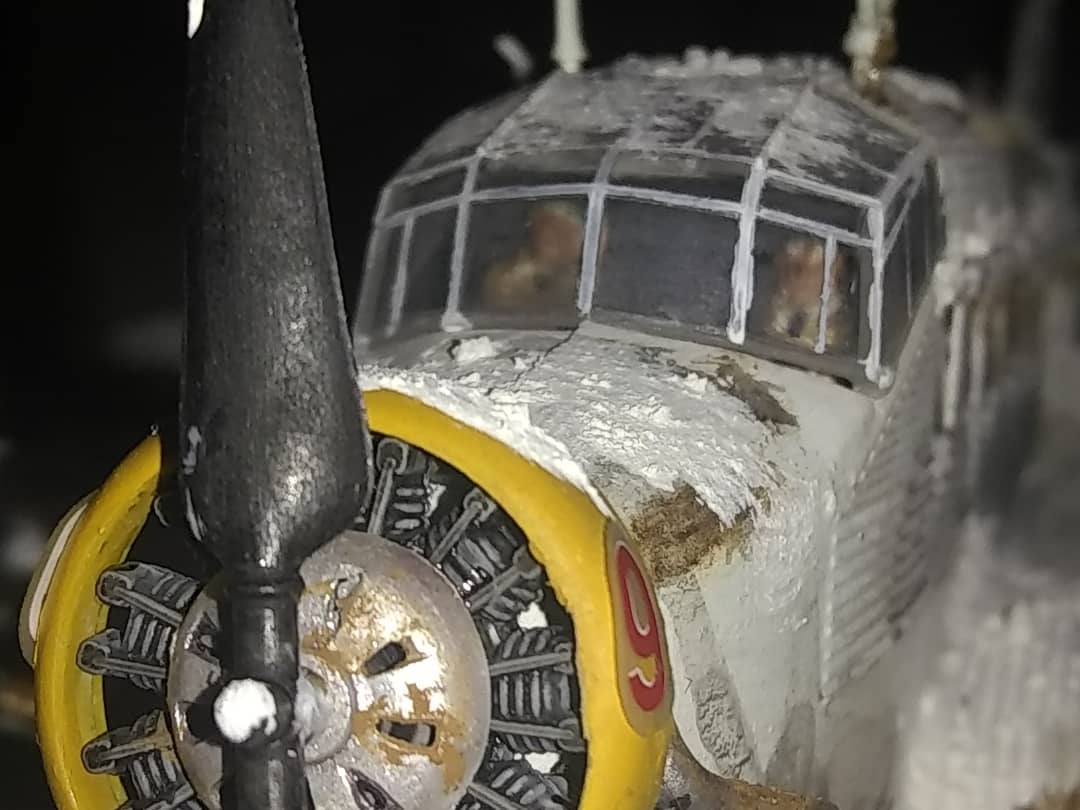
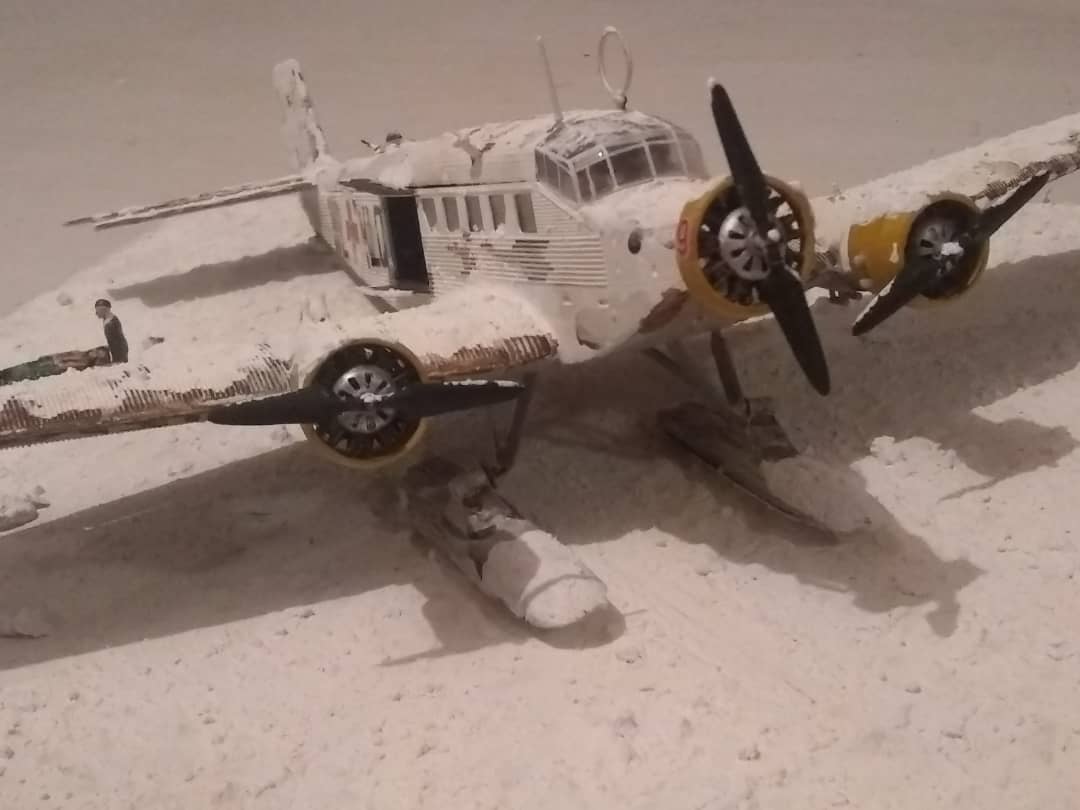
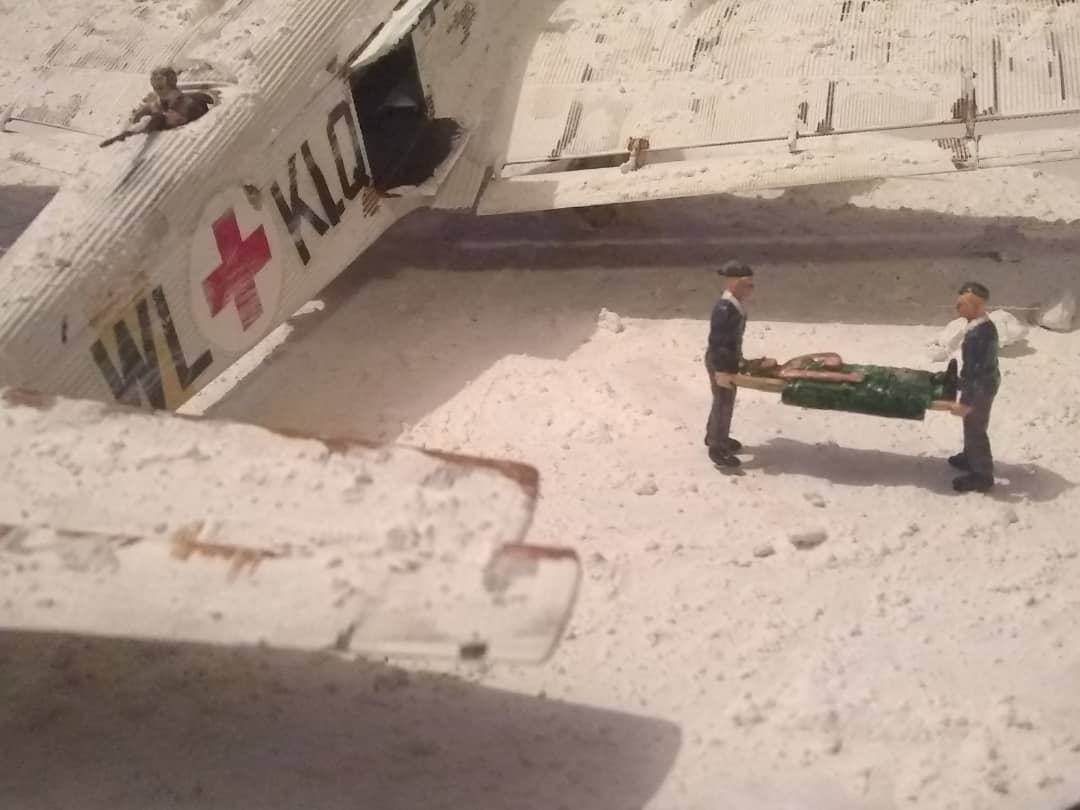
Multiples fotos del modelo finalizado

Dato curioso: En venezuela el Partido Nazi (Partido Nacional Socialista Unido de Trabajadores Alemanes) empezo a operar en 1926, a pesar que en un principio no tuvo mucha relevancia ya que operaban desde el club deportivo alemán. Cuando Hitler asume en el poder el nazismo en venezuela empieza a crecer a pasos agigantados, surgiendo diferentes ramificaciones como la Casa Parda, la Organización de la Ayuda de Invierno, el Frente de Trabajo Alemán, la Juventud Hitleriana, la Juventud Femenina Alemana, el Colegio Humboldt (en un principio no era una institución nazi), entre otros. Aquellos que les interese el tema les recomendaria buscar el libro "El Tercer Reich en Venezuela: El nazismo y la importancia del Caribe en la política internacional" autor: Vicente Quintero; O leer el debate sobre el informe de 1942. En el Archivo Histórico de la AN se encuentran los diarios de debate.
Referencia

Fotografia de la juventud Hitleriana en Venezuela

Noticias de la época (1942) haciendo referencia a la operación Westindien
Fun fact: In Venezuela the Nazi Party (United National Socialist Party of German Workers) began to operate in 1926, although at first it did not have much relevance since they operated from the German sports club. When Hitler assumed power, Nazism in Venezuela began to grow by leaps and bounds, emerging different branches such as the Casa Parda, the Winter Aid Organization, the German Labor Front, the Hitler Youth, the German Women's Youth, the College Humboldt (at first it was not a Nazi institution), among others. Those who are interested in the subject, I would recommend looking for the book "The Third Reich in Venezuela: Nazism and the importance of the Caribbean in international politics" author: Vicente Quintero; Or read the debate on the 1942 report. In the Historical Archive of the AN are the debate diaries.
¡¡¡Un saludo a todos, espero lo disfruten!!!
Greetings to all, I hope you enjoy it !!!

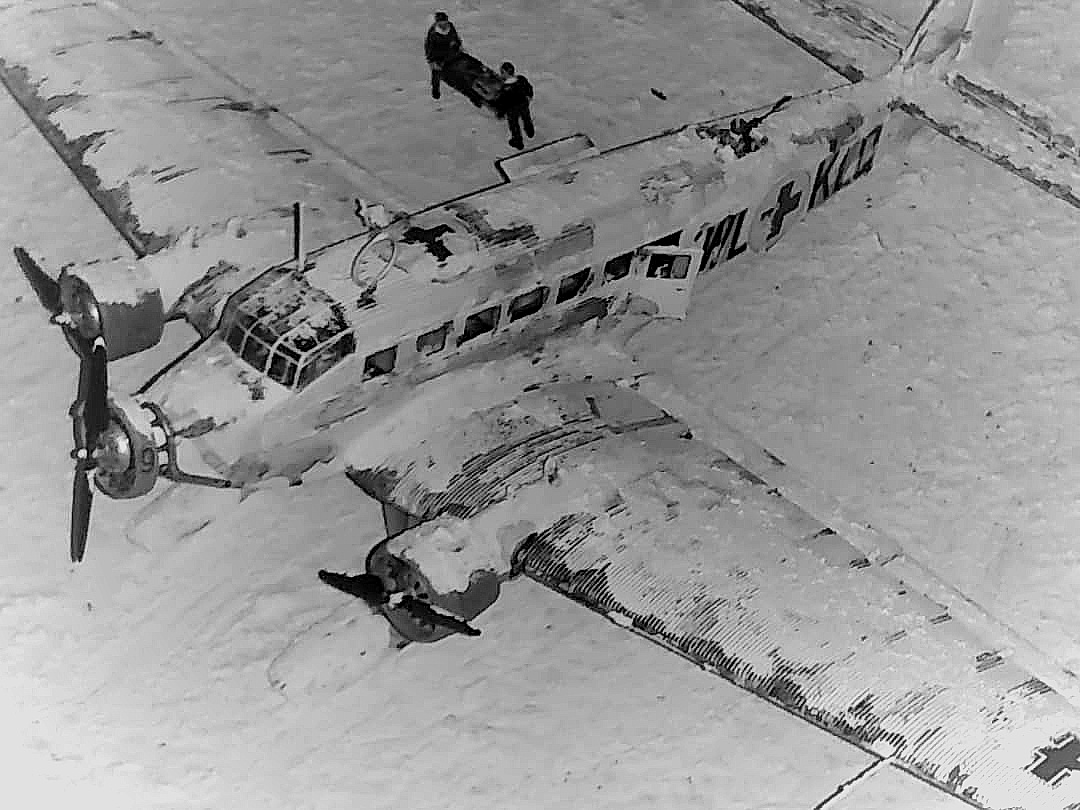
Congratulations, @luisger Your Post Got 50% Boost By @hiveupme Curator.
"Delegate To @hiveupme Curation Project & Earn 95% Curation Rewards"
Contact Us : CORE / VAULT Token Discord Channel or Join Us : UPMELINK Web Site
Waooo amigo esta vez si que te luciste con ese avión miniatura, espectacular tu creación y espectacular tu post.
Muchas gracias amiga, te lo agradezco muchisimo
Congratulations @luisger! You have completed the following achievement on the Hive blockchain and have been rewarded with new badge(s) :
You can view your badges on your board and compare yourself to others in the Ranking
If you no longer want to receive notifications, reply to this comment with the word
STOPDo not miss the last post from @hivebuzz: